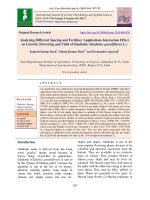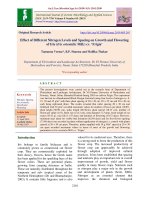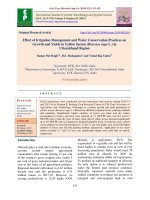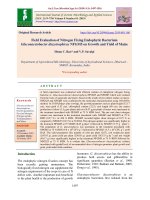Effect of biostimulants sprays on growth and flowering of cut gladiolus (Gladiolus grandiflorus L.) Cv. Arkaamar
Bạn đang xem bản rút gọn của tài liệu. Xem và tải ngay bản đầy đủ của tài liệu tại đây (1.28 MB, 10 trang )
������������������������������������������������������������������������������������������������������������������������������������������������������������������������������������������������������������������������������������������������������������������������������������������������������������������������������������������������������������������������������������������������������������������������������������������������������������������������������������������������������������������������������������������������������������������������������������������������������������������������������������������������������������������������������������������������������������������������������������������������������������������������������������������������������������������������������������������������������������������������������������������������������������������������������������������������������������������������������������������������������������������������������������������������������������������������������������������������������������������������������������������������������������������������������������������������������������������������������������������������������������������������������������������������������������������������������������������������������������������������������������������������������������������������������������������������������������������������������������������������������������������������������������������������������������������������������������������������������������������������������������������������������������������������������������������������������������������������������������������������������������������������������������������������������������������������������������������������������������������������������������������������������������������������������������������������������������������������������������������������������������������������������������������������������������������������������������������������������������������������������������������������������������������������������������������������������������������������������������������������������������������������������������������������������������������������������������������������������������������������������������������������������������������������������������������������������������������������������������������������������������������������������������������������������������������������������������������������������������������������������������������������������������������������������������������������������������������������������������������������������������������������������������������������������������������������������������������������������������������������������������������������������������������������������������������������������������������������������������������������������������������������������������������������������������������������������������������������������������������������������������������������������������������������������������������������������������������������������������������������������������������������������������������������������������������������������������������������������������������������������������������������������������������������������������������������������������������������������������������������������������������������������������������������������������������������������������������������������������������������������������������������������������������������������������������������������������������������������������������������������������������������������������������������������������������������������������������������������������������������������������������������������������������������������������������������������������������������������������������������������������������������������������������������������������������������������������������������������������������������������������������������������������������������������������������������������������������������������������������������������������������������������������������������������������������������������������������������������������������������������������������������������������������������������������������������������������������������������������������������������������������������������������������������������������������������������������������������������������������������������������������������������������������������������������������������������������������������������������������������������������������������������������������������������������������������������������������������������������������������������������������������������������������������������������������������������������������������������������������������������������������������������������������������������������������������������������������������������������������������������������������������������������������������������������������������������������������������������������������������������������������������������������������������������������������������������������������������������������������������������������������������������������������������������������������������������������������������������������������������������������������������������������������������������������������������������������������������������������������������������������������������������������������������������������������������������������������������������������������������������������������������������������������������������������������������������������������������������������������������������������������������������������������������������������������������������������������������������������������������������������������������������������������������������������������������������������������������������������������������������������������������������������������������������������������������������������������������������������������������������������������������������������������������������������������������������������������������������������������������������������������������������������������������������������������������������������������������������������������������������������������������������������������������������������������������������������������������������������������������������������������������������������������������������������������������������������������������������������������������������������������������������������������������������������������������������������������������������������������������������������������������������������������������������������������������������������������������������������������������������������������������������������������������������������������������������������������������������������������������������������������������������������������������������������������������������������������������������������������������������������������������������������������������������������������������������������������������������������������������������������������������������������������������������������������������������������������������������������������������������������������������������������������������������������������������������������������������������������������������������������������������������������������������������������������������������������������������������������������������������������������������������������������������������������������������������������������������������������������������������������������������������������������������������������������������������������������������������������������������������������������������������������������������������������������������������������������������������������������������������������������������������������������������������������������������������������������������������������������������������������������������������������������������������������������������������������������������������������������������������������������������������������������������������������������������������������������������������������������������������������������������������������������������������������������������������������������������������������������������������������������������������������������������������������������������������������������������������������������������������������������������������������������������������������������������������������������������������������������������������������������������������������������������������������������������������������������������������������������������������������������������������������������������������������������������������������������������������������������������������������������������������������������������������������������������������������������������������������������������������������������������������������������������������������������������������������������������������������������������������������������������������������������������������������������������������������������������������������������������������������������������������������������������������������������������������������������������������������������������������������������������������������������������������������������������������������������������������������������������������������������������������������������������������������������������������������������������������������������������������������������������������������������������������������������������������������������������������������������������������������������������������������������������������������������������������������������������������������������������������������������������������������������������������������������������������������������������������������������������������������������������������������������������������������������������������������������������������������������������������������������������������������������������������������������������������������������������������������������������������������������������������������������������������������������������������������������������������������������������������������������������������������������������������������������������������������������������������������������������������������������������������������������������������������������������������������������������������������������������������������������������������������������������������������������������������������������������������������������������������������������������������������������������������������������������������������������������������������������������������������������������������������������������������������������������������������������������������������������������������������������������������������������������������������������������������������������������������������������������������������������������������������������������������������������������������������������������������������������������������������������������������������������������������������������������������������������������������������������������������������������������������������������������������������������������������������������������������������������������������������������������������������������������������������������������������������������������������������������������������������������������������������������������������������������������������������������������������������������������������������������������������������������������������������������������������������������������������������������������������������������������������������������������������������������������������������������������������������������������������������������������������������������������������������������������������������������������������������������������������������������������������������������������������������������������������������������������������������������������������������������������������������������������������������������������������������������������������������������������������������������������������������������������������������������������������������������������������������������������������������������������������������������������82.23
3.53
8.66
7.40
T10 Fulvic acid
4ml
65.53
14.16
83.63
3.56
8.90
7.90
T11 Control
With out
spray
74.63
9.73
75.23
3.23
8.06
6.66
1.60
0.41
1.44
0.15
0.26
0.21
4.70
1.20
4.23
NS
0.77
0.64
SEM ±
CD (P = 0.05)
1746
Int.J.Curr.Microbiol.App.Sci (2019) 8(9): 1742-1751
Table.3 Effect of bio stimulants on floral parameters of cut gladiolus cv. Arkaamar
Treatments
No. of florets
-1
spike
Fresh weight
of floret (g)
Spike longevity
on the plant
(days)
No. of spikes
-1
plant
Spike yield
-1
plot (spike
No./plot)
Spike yield ha
(spike lakh
No./ha)
T1
Triacontanol
2ml
10.50
3.10
13.30
1.03
31.13
1.38
T2
Triacontanol
4ml
11.42
3.26
14.10
1.30
31.16
1.38
T3
Cytozyme
2ml
10.50
3.13
13.90
1.30
31.33
1.39
T4
Cytozyme
4ml
11.50
3.26
14.56
1.10
31.66
1.40
T5
Biozyme
2ml
10.30
3.16
15.23
1.16
32.33
1.43
T6
Biozyme
4ml
12.60
3.20
15.66
1.26
33.33
1.48
T7
T8
Humic acid
Humic acid
2ml
4ml
12.00
13.60
3.46
3.73
16.20
18.32
1.56
2.0
37.33
41.33
1.65
1.83
T9
Fulvic acid
2ml
13.10
3.13
15.33
1.10
31.00
1.37
T10
Fulvic acid
4ml
13.00
3.30
15.86
1.30
34.33
1.52
T11
Control
With out
spray
10.20
2.63
12.04
1.00
28.00
1.24
SEM ±
0.47
0.12
0.67
0.09
1.03
4.67
CD (P = 0.05)
1.40
0.35
1.99
0.27
3.06
1.36
1747
-1
Int.J.Curr.Microbiol.App.Sci (2019) 8(9): 1742-1751
Imposition of treatments
Vegetative growth of cut gladiolus cv.Arkaamar
1748
Int.J.Curr.Microbiol.App.Sci (2019) 8(9): 1742-1751
Biostimulantsprays 30 days after corm sowing
Over view of experimental site
The data significantly revealed that maximum
floret count spike-1was recorded in treatment
T8 (13.60) which was followed by Fulvic acid
2ml/l (13.10) depicted in fig.4. It might be due
to inhibition of peroxidase activity by humic
acid due to auxin breakdown promoting the
number of florets, these results are similar
findings of Muscoloet al., (1993).Production
of larger floret (8.73 cm) and maximum length
of floret (9.90 cm) was recorded over the
control when applied humic acid at 4ml/l
represented in fig.5. It might be due to
1749
Int.J.Curr.Microbiol.App.Sci (2019) 8(9): 1742-1751
gibberellin like activity of humic acid, these
are confirmation with findings of Vaughan
(1974); Naik and Jature (2010).
activity (Padmapriya, 2000).These findings
are in agreement with SubeshRanjith Kumar
(2003) in Chrysanthemum.
A critical examination of the data revealed
that, maximum fresh weight of floret (3.73
g)was recorded with foliar spraying of Humic
acid at 4ml/l, it may be due to humic
substances increasing the growth and
providing a greater fresh weight of floret
(Canellas et al., 2000). Similar findings were
observed by Baldotto et al., (2013).The
maximum duration of flowering was recorded
in the plants treated with Humic acid at
4ml/li.e T8 (16.53 days) which was followed
by Humic acid at 2ml/l-T7 (14.80 days). It
might be due to presence of humates which
enhanced nutrient uptake, improved soil
structure (Gupta et al., 2013) in
chrysanthemum. Among the treatments tried,
the treatment humic acid at 4ml/li.e T8 showed
maximum spike longevity on the plant (18.32
days).This might be attributed due to the entry
of humic acid into the plant, which might have
altered the carbohydrate metabolism of plants
promoting the accumulation of sugar (Cacco
and Dell Agnola1984).
From the current study it can be concluded
that application of cormpre soaking and foliar
sprays withHumic acid at 4ml/li.e T8 appears
to be an optimum treatment for enhancing
growth and flowering of cut gladiolus Cv.
Arkaamar.
Gladiolus Cv. Arkaamar plants treated with
Humic acid 4ml/li.e T8 foliar spray produced
significantly maximum number of spikes
plant-1 (2.0)an increased in the number of
spikes per plant due to Humic acid which
consisted of active phenolic group would have
inhibited oxidase activity and promoted the
prolonged persistence of IAA in plants that
might have contributed to the increased yield
of spike as opined by Muscoloet al.,
(1993).Maximum number of spikes per plot
and hectare(41.33& 183703.53 respectively)
was recorded in Humic acid 4ml/l-T8which
was followed by Humic acid at 2ml/l depicted
in fig.6.The obtained result might be due to
the organic acids present in humic acid inhibit
IAA oxidase enzyme and thereby increased
the flowering process with effective auxin
References
Ahmad, I., Saquib, R. U., Qasim, M., Saleem,
M., Khan, A. S., and Yaseen, M.
2013.Humic acid and cultivar effects
on growth, yield, vase life, and corm
characteristics of gladiolus.Chilean
Journal
of
Agricultural
Research.,73(4).
Azza, A. M., Mazhar, Shaymaa, I., Shedeed,
N. G., Abdel, A., Mona, H. and
Mahgoub. 2012. Growth, flowering
and
chemical
constituents
of
Chrysanthemum indicumL. plant in
response to different levels of humic
acid and salinity. Journal of Applied
Sciences Research., 8(7):3697-3706.
Baldotto, M. A. and Baldotto, L. E. B.
2013.Gladiolus
development
in
response to bulb treatment with
different
concentrations
of
humicacids.RevistaCeres., 60(1):138142.
Bashir, M., Qadri, R. W. K., Khan, I., Zain,
M., Rasool, A., and Ashraf, U.
2016.Humic acid application improves
the growth, floret and bulb indices of
gladiolus (gladiolus grandiflorus L.)
Pakistan Journal of Science., 68(2).
Cacco, G. and Agnola, G. D. 1984. Plant
growth regulator activity of soluble
humic complexes. Can.J.Soil Sci.,
64(2):225-228.
Canellas, L. P., Berner, P. G., Silva, S. G.,
Silva, M. B and Santos, G. A. 2000.
1750
Int.J.Curr.Microbiol.App.Sci (2019) 8(9): 1742-1751
Fractions of organic matter in six soils
of a topos sequence in the state of Rio
de Janeiro. Pesq. Agropec. Bras.,
35:133-143.
Cosenova, D. F. E., Arguello, J. A., Abdulla,
G. and Orioli, G. A. 1990.Content of
auxin inhibitor and gibberellinlike
substances in humicacids.Biol. Pl.,
32(5):346-351.
Gupta, V. N, Chakrabarty, D. and Datta, S. K.
2013. Influence of different holding
solutions on post-harvest behavior of
cut
flowers:
Chrysanthemum
(Dendranthema grandifloraTzevlev).
J. Orn. Hort., 9(2):80-84.
Kauffman, G. L., Kneivel, D. P., Watschke, T.
L. 2007. Effects of a biostimulant on
the heat tolerance associated with
photosynthetic capacity, membrane
thermostability,
and
polyphenol
production of perennial ryegrass. Crop
Sci., 47:261-267
Mato, M. C. and Mendez, J. 1970. Effect of
humic substances on some enzyme
activities. Geoderma., 3:255.
Muscolo, A., Felici, M., Concheri, G. and
Nardi, S. 1993. Effect of earthworms,
humic substances on esterase and
peroxidase activity during growth of
leaf explants of Nicotianaplum
baginifolia. Biol.Fertil.Soils., 15(2):
127-131.
Naik, P. G and Jature, S. D. 2010.Effect of
bioenzymes on flower quality, yield
and vase life of rose (Rosa indicaL.)
Cv. Gladiator. The Asian Journal of
Horticulture., 4(2):311-313.
Padmapriya, S. 2000. Effect of gibberellic
acid and certain other chemicals on the
cutflower
production
of
chrysanthemum
(DendranthemagrandifloraTzelev.)
cultivars. M.Sc., (Hort) Dissertation
submitted to Tamil Nadu Agrl.
University, Coimbatore.
Panse, V. G. and Sukhatme, P. V.
1985.Statistical
Methods
for
Agriculture Workers. ICAR, New
Delhi, 14-33.
Pritam, S., Garg, V. K., and Kaushik, C. P.
2010. Growth and yield response of
marigold to potting media containing
Vermicompost
produced
from
different wastes. Environmentalist.,
30(2):123-130.
Sadhu, M. K. and Bose, T. K. 1973.Tuberose
for most artistic garlands. Indian
Horticulture., 18:17-21.
SubeshRanjith Kumar, C. 2003. Studies on
standardization of package of practices
for
cut
chrysanthemum
(Dendranthema grandifloraTzvelev)
cv. Yellow Regan under protected
cultivation. Ph. D Thesis, Tamil Nadu
Agricultural University, Coimbatore.
Vaughan, D. 1974. Effects of hydroxyproline
on the growth and cell wall protein
metabolism of excised root segments
of Pisum sativum. Planta (Berl.),
115(2):135-145.
Vaughan, D., Malcolm, R. E. and Ord, B. G.
1985. Influence of humic substances
on biochemical processes in plants. In:
Soil organic matter and biological
activity (Ed. Vaughan, D. and
Malcolm, R. E.). Martinus Nijhoff,
Dordrecht., 77-108.
How to cite this article:
Ravikumarbolagam and Seenivasan Natarajan 2019. Effect of Biostimulants Sprays on Growth
and Flowering of Cut Gladiolus (Gladiolus grandiflorus L.) Cv. Arkaamar.
Int.J.Curr.Microbiol.App.Sci. 8(09): 1742-1751. doi: />
1751









